In November 2020, I launched a series of autobiographical blog posts entitled “Picture Postcards of France” with this initial post: https://stephenhgrant.com/picture-postcards-of-france-1/. I presented 9 postcards of these locations: Paris, Port-de-Bouc, Marseille, Cannes, Nice, Grasse, La Ferté-sous-Jouarre, and Lizy-sur-Ourcq.
The second “Postcards of France” post presented 6 humorous cards I had received in the mail over the years: https://stephenhgrant.com/picture-postcards-of-france-2/.
During Covid, I find myself producing deltiological memoirs. (Deltiology is the study of postcards.) I hope you find the posts interesting and informative.
At Annick Pasquet’s and my wedding in Grasse in 1965, all four of our parents were present. None of the eight grandparents attended, although two French grandmothers and one American grandmother were alive. One of the French grandmothers lived in Brittany. Her name was Adeline née Robin Roullet. She was a character. She was known to have said “I am never going to leave Brittany because I do not want to die anywhere else.” Her husband Jules Roullet had died on Nov. 19, 1957 at age 72. Adeline referred to him as “feu mon bonhomme.” Annick’s mother, Raymonde Roullet, was the only child of Jules and Adeline. Adeline Roullet died on Nov. 13, 1982, at age 92. In sections of this blog post you will read how a grandchild and two great grandchildren remember Adeline.
Annick’s family traveled by train every summer to visit her maternal grandmother in the Department of Loire Atlantique. Adeline lived alone in a house not in a city or a town or a l village, but in a “lieu dit.” Within Communes there exist administrative divisions referred to as a “lieu-dit” (literally “said location”). It is a toponymic term for a small geographical area bearing a traditional name. One of the “lieux-dits” (plural) in the Commune of Fégréac is Pont-Miny. The locality’s population may consist of 100 souls.
We are talking about one of the most rural places in France. The “Pont” of “Pony-Miny” referred to a real bridge, one of the small bridges over the canal from Nantes to Brest. The canal’s construction was completed in 1836; it is 240 mi. long and contains 238 locks.
Annick introduced me to members of her family who also made the trip in the summer to Pont-Miny from the locations where they lived during the year. The names I recall now in 2021 are the following. Arthur Claes, a Belgian, whose profession was to make trumpets. Then Paulette & René, Daniel & Anne Boissay. Across the street from where Adeline lived were houses that appear in a few postcards produced around the time of WWI. Living in them during the year were Georgette and Tante Elise. Annick related that other relatives of a previous generation who had lived across the street from her grandmother did not have names. I asked her, “What do you mean, no names.” “Well, we never knew their names.” “Then, what did you call them”? “One was called Quatre Pattes. And his son we all referred to as Fils de Quatre Pattes.” I found this story clochemerlesque!
This third “Postcards of France” post features the French Administrative Region of Brittany. Brittany in northwestern France has a population of five million people. This theme is personal for me, as I married a French lady with maternal roots in Brittany, Annick. That name is the Celtic form of Anne. The post will contain three stories in italics, in this order, from these people: my son Yonel, my daughter Sylviane, and my former sister-in-law, Michele. Then making a brief appearance is my former mother-in-law, Raymonde, in a comment on an old picture postcard depicting washing day in the town of Dubreka in Guinea. But first, more French geography.
Fig. 1. Map of France Indicating Brittany (Wikipedia)
The geographic term “Department” of France is one of the three levels of government below the national level and between administrative regions and communes. I will highlight the Department of “Loire-Atlantique” but it was not always thusly named. Wikipedia informs us that “Loire-Atlantique is one of the original 83 Departments created during the French Revolution. Originally, it was named Loire-Inférieure, but its name was changed in 1957 to Loire-Atlantique. The area is part of the historical Duchy of Brittany, and contains what many people still consider to be Brittany’s capital, Nantes.”
Fig. 2. Region of France Indicating Pays de la Loire (Microsoft Maps)
In the 1950s, the country was divided up into 18 regions, “Pays de la Loire” is one of the 18 regions of France, in the west of the mainland, to serve as a zone of influence for its capital, Nantes.”
Fig. 3. Trade Card of Loire-Inférieure (Author’s collection)
This is not a postcard, but a “trade card” with smaller dimensions. The featured trade is chocolate making. The artisans are Trappist monks in the Aiguebelle Abbey in the Department of the Drome. What is their slogan, you might ask? “I melt for you!” “Nantes” is written in big capital letters.
The geographic term “Commune” of France is the lowest administrative division in France. It represents all parts of a town or a village. Let’s look at two postcards from two communes in Loire-Atlantique: Saint-Gildas-des-Bois and Saint-Nicolas-de-Redon (in the Breton language, Sant-Nikolaz-an-Hent). Both communes are on the trade card map, in the northwestern corner, circled in red.
Fig. 4. Commune of Saint-Gildas-des-Bois in Loire-Atlantique (Author’s collection)
In this undated card, the scene shows fenced-in farm animals in front of the village parish, stone residences and administrative buildings, where the rural bumps right up against the town. The photographer was named Rialland.
Fig. 5. Commune of Saint-Nicolas-de-Redon in Loire-Atlantique (Author’s collection)
In postcard #1585 sent in 1908, mothers clad in black have brought their clothes on hand-made wooden wheel barrows down to the “Canal from Nantes to Brest” for washing. Women are kneeling or on hands and knees, and have pails or tubs. Some wear the traditional “coiffes,” headwear from Brittany. Behind the double row of poplar trees one sees white laundry already hanging up to dry. Two children turn their backs on the washing scene, perhaps intrigued by the photographer’s equipment. The photographer with studio in Nantes is Vassellier.
Fégréac is a commune in the Loire-Atlantique Department too small to have made it into the Aiguebelle map! Postcard #1067 of the “Canal de Nantes a Brest” was sent in 1913. The single row of trees is in bloom. Two fishermen stand on the right, and a boatman to the left stands up in his hand-made wooden boat. The photographer is identified as Lacroix Chateaubriant.
Fig. 6. Commune of Fégréac in Loire-Atlantique (Author’s collection)
A boatman and a fisherman are pictured in Fig. 6. photo by Lacroix taken somewhere in Fégréac.
Fig. 7. Pont-Miny in the Commune of Fégréac (Google Maps)
Fig. 8. Adeline’s house in Pont-Miny, Loire Atlantique (Wikipedia)
Fig. 7. shows the Rue de Pont Miny. Fig. 8. Points out with a magenta circle Adeline’s house on the rue de Pont Miny. In the following two descriptions, my son Yonel Grant and daughter Sylviane Grant encapsulate what Pont-Miny means for them.
Written by Yonel Grant, November 2020
Throughout the 1970s and into the 80s every summer my mother Annick, sister Sylviane and I flew back from Boston in August and after changing planes in Paris, we would fly into Nantes Chateau Bougon airport to spend 10 days with my great-grandmother Adeline in Pont Miny. There were plenty of people around – uncles, aunts, cousins. My father Steve accompanied us sometimes but typically it was just the three of us. At that time, Pont Miny had a population of about 100. In my child’s eyes, everyone in sight was a VERY senior citizen except the two kids at the farm next door. I loved seeing my great-grandmother again and settling into the Pont Miny life. From the outdoor toilet (a simple outhouse) to the outlook of the people it was always a culture shock––a healthy one for us kids.
One of my fondest memories was collecting blackberries. In this region of France, French farms dominate the countryside, alternating cattle and wheat fields. Huge blackberry bushes grew on both sides of the fences and by late summer the blackberries grow a luxuriant shiny black. You can even smell them. When the family decided to collect berries, it was a serious affair. We’d go out in two or three cars with metal and plastic buckets, plastic tubs, reed baskets woven by my great-grandfather. Seven to ten of us (i.e., everyone in the household except for grand-mere Adeline) would fan out and pick and eat, pick and pick, until 2–3 hours later we’d had enough. Enough meant 20 pounds or more of the black stuff. Most of us were scratched from head to toe from the bramble (apart from some wiser adults who had remembered to wear long sleeves), our clothes stained and our tongues dark purple. Grand-mere Adeline would cook the blackberries in a huge brass pot right in the chimney, and for the rest of the stay we would have the best jam in the world for breakfast.
Fig. 9. The Farm Nearby Grandmere Adeline’s house in Pont-Miny (Wikipedia)
The farm area of which Sylviane writes is circled in magenta.
Written by Sylviane Grant, December 2020
As a child, mornings in Pont-Miny (Brittany) began with fetching milk from the nearby farm. As I came downstairs, Adeline, my French great grandmother, would greet me with a smile, a peck on both cheeks, and hand me an empty terracotta pitcher. Careful not to drop it, I’d walk through the back door and along a dirt path lined with a thicket of tall trees and thorny blackberry bushes, towards the sound of the cows calling through a cacophony of chirping birds. Across from Adeline’s modest house, chicken coop and large barn, tree-lined fields extended as far as the eye could see. Solid stone ruins heroically stood along the path, vestiges of World War II, when the village, including Adeline’s home, had been bombed by Germany. It had since been rebuilt with simple 1-2 story white or grey stucco homes, some so close as to share a common wall. Gazing at the stone remains, I imagined how the village had looked in its former charming glory. A few of Adeline’s chickens, who’d preceded me outside, pecked along the path, while others had vanished into nature. At dusk, she’d call: “Petits, petits, petits!” and they’d obediently scurry back across the path and into their coop through a chicken-sized door.
As one neared the farm, cow calls grew stronger, as did the earthy scent of manure and hay. The family-owned farm was comprised of several huge fields where the cows grazed during the day, 3 massive barns as well as other austere looking buildings positioned around a central courtyard. The milking barn doors were flung open; inside, thirty or so black and white cows stood chained side by side, facing a feeder wall. Their names, Marguerite, Rose, Lorette, Ginette, Magali, Maude, Jackie, Berthe, etc., were inscribed on chalkboard plaques affixed to the wall above their heads. Visitors entering the building were greeted by their imposing rears and flickering tails. The farmer’s wife was always working, seated on a 3-legged stool, using a handheld milking machine with tubes pouring the milk into large aluminum vats. She’d return my greeting, smile and reach out for my pitcher.
I carefully maneuvered my way home over potholes to avoid spilling the precious liquid. Adeline would heat it up and make steaming café au lait (coffee with milk) and lait au chocolat (chocolate milk) for the family to enjoy with breakfast. Her “tartines”, topped with Brittany butter and a fragrant layer of her homemade “gelée de mûres” (Blackcurrant jelly), were delicious. She made her jams and jellies in a large copper pot, from the large baskets of wild berries or fruit we picked in the area during our afternoon walks. Adeline grew and raised most of what she consumed. Her vegetable garden and fruit trees fed the whole family. She had no refrigerator but stored perishables in a thick-walled cellar which remained cold during the hottest of days. Her potatoes, beans, pears and cabbages lasted her throughout the winter. Her hens provided fresh eggs daily, and she occasionally prepared a chicken from her coop. On a weekly basis, a vendor would stop his van in front of her house to sell residents fresh regional cheeses, fish, or household item. The farm is since long gone, as is the vendor with the van. Adeline’s house now has a refrigerator, but my appreciation for the times when such a luxury didn’t exist remains.
Below, my former sister-in-law Michèle Pasquet and my former mother-in-law Raymonde Pasquet write about summer vacation in Pont-Miny and visiting Guinea, respectively.
“La grosse fraise” par Michèle Pasquet, Novembre 2020
Grand’mère Adeline nous attendait à Pont-Miny, son village en Bretagne,( à 10 Kms de Redon et 45 kms de St Nazaire) impatiemment, chaque année, pour notre unique passage annuel, du mois d’août au mois d’octobre. Quand nous arrivions chez elle, (après notre long voyage en train depuis notre domicile à Port-de-Bouc, près de Marseille, à plus de 1 000 kms), en un quart de tour, nous étions déjà éparpillés dans le village ou dans le jardin. Il nous fallait, malgré la bonne taille de la maison, être dehors tout de suite, pour sentir les vacances commencer ! .
Chacun avait dans la tête ses petits rendez-vous : soit les retrouvailles avec la copine, ou les cousins, soit le bord du canal (appelé canal de Nantes à Brest), soit le jardin avec ce qu’il pouvait y avoir de nouveau !… les poules et leurs poussins nés à Pâques, les arbres fruitiers (en particulier les poiriers avec leurs bonnes poires William, si délectables qu’on les savoure à l’avance) avec ce qu’ils avaient de prometteur dans l’été, puis les salades, le persil, les carottes, les poireaux, les oignons, les rutabagas …, tout ce qui permettait à Grand’mère de nous réjouir les papilles, soupe comprise !…
J’avais, pour ma part, mis en priorité de revoir ma copine Monique et de jeter un œil discret aux deux rangées de fraisiers que notre grand’mère entretenait avec le plus grand soin, chaque année.
Cette partie du jardin était de toute beauté ! Grand’mère Adeline mettait toute son énergie et son âme pour retourner la terre noire et brillante, bien arrosée par l’eau abondante du ciel breton. J’étais toujours frappée par le beau damier des salades au vert vernissé, pommées et craquantes quand nous les mangions ! Côté fleurs, je faisais aussi l’inspection : le camélia apparemment avait bien traversé l’hiver, sans geler et jaunir ses pompons blancs (Adeline fournissait souvent un gros bouquet aux jeunes mariés du voisinage … . Le laurier-sauce avait encore grandi, le muguet s’étalait à ses pieds (il a gardé son emplacement encore aujourd’hui !), et surtout, en bordure du potager, j’admirais les dahlias géants avec leurs énormes corolles, jaunes et pourpres qui trônaient ensuite sur le buffet de Grand’mère, lui procurant une grande fierté.
A notre arrivée en juillet, les rangs de fraisiers laissaient apparaître ça et là des fraises rougeoyantes, de taille différente,
en grand nombre.
« – Grand’mère ! Grand’mère ! lui criais-je avec toute la force de mes cordes vocales, viens voir !
Ma grand’mère accourut, pensant à un événement majeur…
– Eh bien, qu’y a- t il ? Interrogea t-elle, en notant rien d’anormal.
– Mais tu l’as vue !?
– Mais quoi, dis-moi ! Qu’ est-ce que tu me racontes ?
– Eh bien, c’est une fraise, pas comme les autres, énorme, ENORme, franchement ENORME !!!
– En effet ! Tu as raison ! Elle a la taille presque d’un oeuf ! dit-elle me confirmant ainsi la rareté de ma découverte… Elle rajouta :
– Elle sera, quand elle sera mûre, pour le plus sage d’entre vous, car je ne pourrai pas la partager en sept !… ». (La famille nombreuse venait encore entraver la situation… )
Cette promesse me parut alors judicieuse et je me mis, les jours suivants, en position de lauréate.
Je faisais attention à tout : j’évitais de dire des gros mots, j’aidais à mettre les nombreuses assiettes sur la table, à me tenir droite sur mon siège, à ne pas mettre les coudes sur la table, à bien finir mon assiette, à chercher les petits services à rendre, bref à être gentille car j’avais bien envie de gagner la grosse fraise !. Je me demandais si elle aurait un goût de vraie fraise comme celles de d’habitude. J’étais à la fois habitée par la gourmandise et la curiosité. Je voulais en faire mon affaire ! .
Quelques jours passèrent sans en reparler. Il me semblait que seules, ma Grand’mère et moi, partagions l’image de la grosse fraise, l’idée de son destin et de son attribution. Furtivement tous les jours, j’allais lui jeter un œil en priant qu’il n’y ait pas un intrus, comme une limace ou un escargot qui passerait à table avant moi !…
Enfin, me disais-je, cela devrait être le bon moment de cueillir ce fruit miraculeux maintenant parvenu à sa pleine maturité. D’un pas conquérant, j’avançais dans la rangée des fraisiers, sûre de ma discrétion.
Je prenais mon temps pour scruter cette rangée aux fruits si délicats qui rougeoyaient si vite dans la chaleur enveloppante de juillet… je voyais déjà nos petites assiettes de dessert remplies de ces savoureuses fraises, léchées par chacun, en cachette bien sûr, pour ne rien perdre du bon jus !…
Pendant que j’élucubrais ainsi, un doute me traversa : bizarre, bizarre ! … J’ avais du mal à poser mes yeux sur le fameux trésor ! Mais où était-il donc passé ? Je ne voulais pas crier tout fort mon trouble et à toutes enjambées, j’allais trouver ma Grand’mère dans sa cuisine.
« – Je ne comprends rien, je ne vois plus la grosse fraise ! » lui disais-je, toute essoufflée.
– Comment ça !? Tu ne la vois plus ? Ce n’est pas possible, je ne l’ai pas cueillie !!
Allons au jardin regarder ça ensemble ! »
Elle me prit par la main et nous courûmes ensemble jusqu’au fraisier tant convoité. Le constat navrant de la disparition de la fraise éléphantesque se confirma…
Ma Grand’mère, très embarrassée, fit son enquête, telle Sherloch Holmes …
Il s’avéra que le chenapan fautif fut mon grand frère qui, croyant bien faire, nous expliqua t-il, se l’attribua, en toute sérénité, étant donné qu’il aurait été ridicule de la partager en sept, et qu’en somme, il s’était dévoué pour éviter cette situation cornélienne !
(Great) grandmother Adeline Roullet & granddaughter Michèle collecting morning eggs in Pont-Miny
Fig. 10. Ma visite à la Guinée en 1991 par Raymonde Pasquet (Photo by author)
Raymonde Pasquet, my former mother-in-law, visited our family in Conakry, Guinea, for several weeks in 1991. That year, my first of three postcard books was published; it was a collaborative effort: Durr, P., Grant, S., Sivan, S., Tompapa, E., Images de Guinée. Conakry, Guinea: Imprimerie Mission Catholique, 1st ed. 1991, 2nd ed. 1994, 147 pp. She chose one page of the book on which to consolidate impressions of her visit:
Ce payseage est très évocateur pour moi de la Guinée profonde telle que je l’ai découverte à travers mes promendades avec Annick et au cours de la visite d’une semaine avec Steve des écoles de villages. J’ai conservé un souvenir émerveillé de la nature exubérante, de la vie simple et authentique des habitants, de leur hospitalité––comme j’ai été frappé par l’application des écoliers et l’ardeur des maîtres nouvellement impliqués dans l’enseignement du français. Je remercie mes enfants de m’avoir permis cette approche de la vie réelle de la Guinée.
Fig. 11. Raymonde Visiting a Charity that Makes Prosthetics (Photo by author)
In Guinea, I worked two years as head of the education and training office at USAID, the foreign assistance program of the US government. I invited Raymonde to accompany me and my Guinean counterpart on a week’s tour of elementary schools upcountry. An extra bonus of the trip was to visit a center that manufactured wheelchairs and prosthetic devices for some the disabled Guinean population. Let me say that Raymonde’s appearance in a Guinean village was a huge hit. What did villagers notice first and comment on? All her white hair. They said they had never seen a person with so much white hair. Guineans––both men and women––with white hair tend to cut it very short. And there are many fewer people with white hair because Guineans die much younger than do, say, French people. Raymonde always drew a crowd; there are 12 people here. The crowd thanked her for stopping in the village and meeting them; especially her shaking hands with them individually meant a lot.
Fig. 12. Postcard of Canal at Pont-Miny #1 (Author’s collection)
When I showed Raymonde the picture postcards of Pont-Miny that I had acquired at flea markets in Paris or Nice, or in Parisian postcard boutiques, she looked them over carefully. Her reaction was, “I remember that these were the postcards being sent when I was young growing up here, but I don’t recognize any of the people on the cards.” Postcard #1 shows three men and two women smiling and looking toward the photographer as they pose above the canal. The card was mailed in Fégréac in 1914 and sent to a doctor in Nantes.
Fig. 13. Postcard of Canal at Pont-Miny #2 (Author’s collection)
The photo for postcard #2 was taken from the other side of the road. The “X” over the double-chimneyed stone house might have been where the correspondent Louise was staying when she sent the card in 1923 to a couple in the 7th arrondissement in Paris. The card is quite artistic with the reflection of the canal that a local uniformed official is contemplating. A second behatted man is leaning against the railing on the canal bank.
Fig. 14. Postcard of Canal at Pont-Miny #3 (Author’s collection)
Postcard #3 is the same as postcard #2, but not quite. In the lower left of #2 there is one bush; in #3, two bushes are visible. The cards were produced by the same Monsieur F Chapeau, publisher in Nantes. One wonders why one card bears a ten-centime stamp and the other a twenty-five-centime stamp.
Fig. 15. Postcard of Canal at Pont-Miny #4 (Author’s collection)
Postcard #4 leads us back across to the other side. It’s another F. Chapeau card from Nantes. It gives a full-length view of a vintage canal barge used for freight.
Fig. 16. Postcard of Canal at Pont-Miny #5a (Author’s collection)
If in the first postcards men were dominant, in this last card girls and ladies have taken over. Clothed either in white or in black, the women are fishing.
Fig. 17. Postcard of Canal at Pont-Miny #5b (Author’s collection)
To conclude this blog post, we evoke the message by a young hand on the reverse side of postcard #5, confirming the essential rural nature of Pont-Miny which could not be expressed more simply or aptly than by the phrase, “Je vais garder les vaches avec Marie” (I will tend the cows with Marie). But wait, I believe this youngster is a budding deltiologist! She asks, “tache de m’envoyer une carte du croisic” (try to send me a card from Le Croisic). Look for Le Croisic in Fig. 3. on the coast of the Department of Loire-Inférieure.
COMMENTS:
6 Comments
Submit a Comment
CONNECT

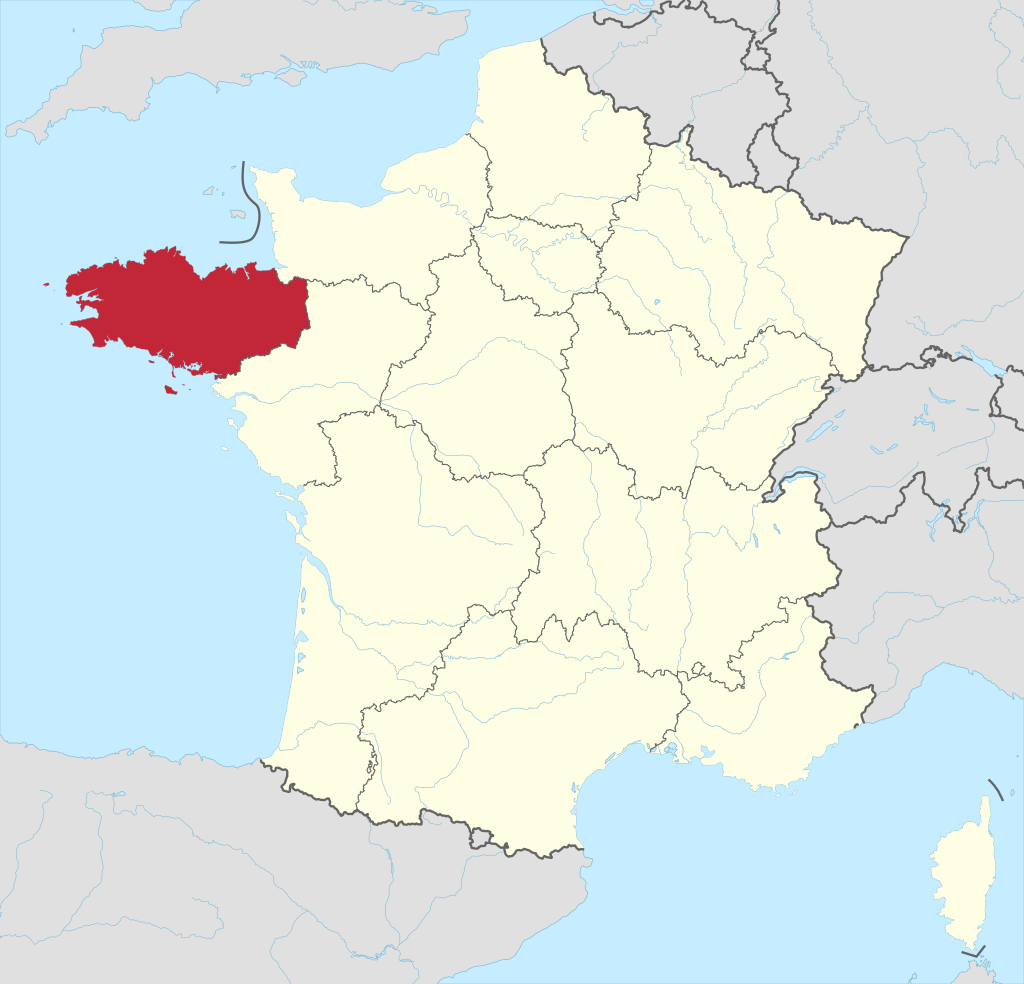

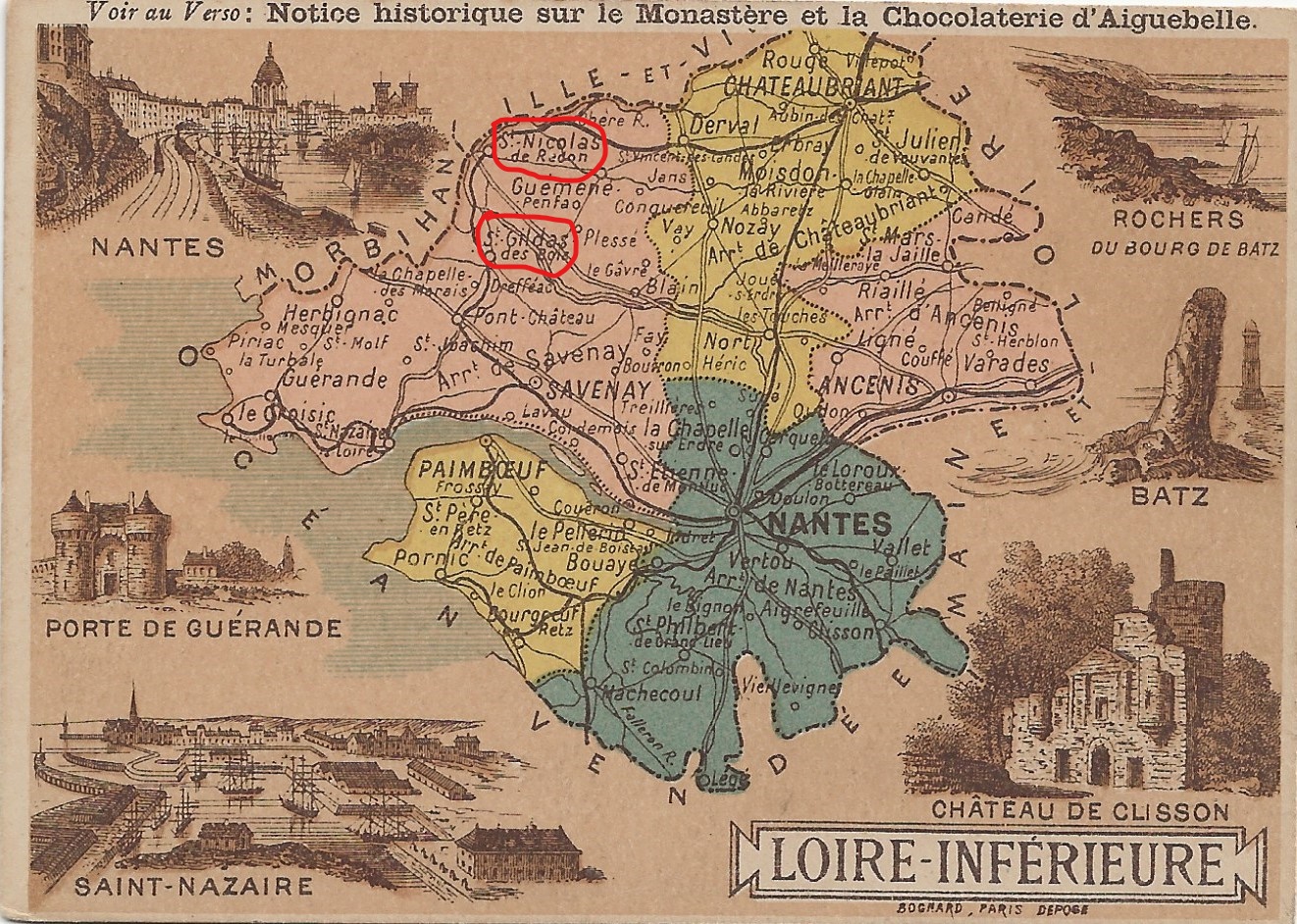
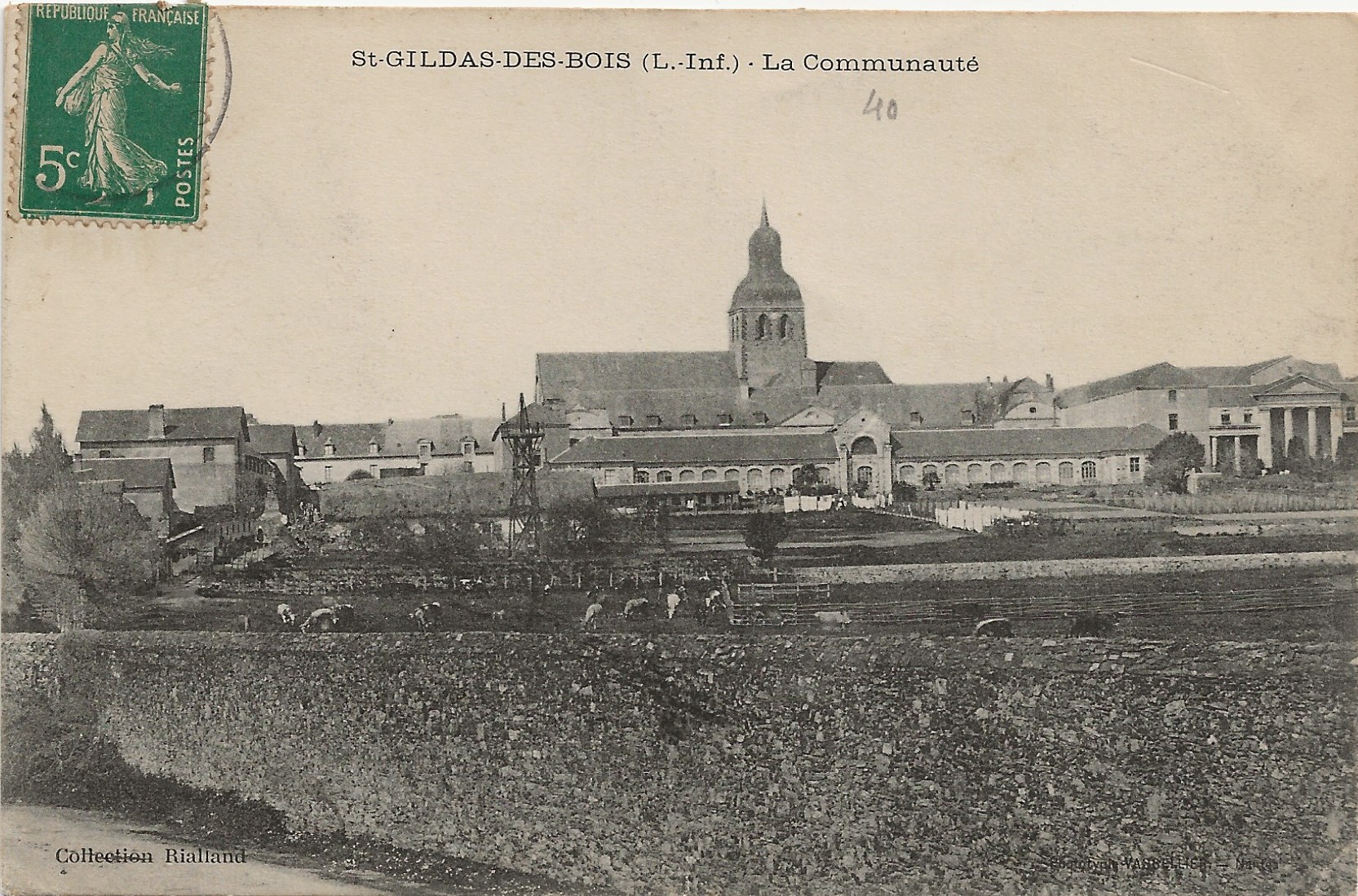
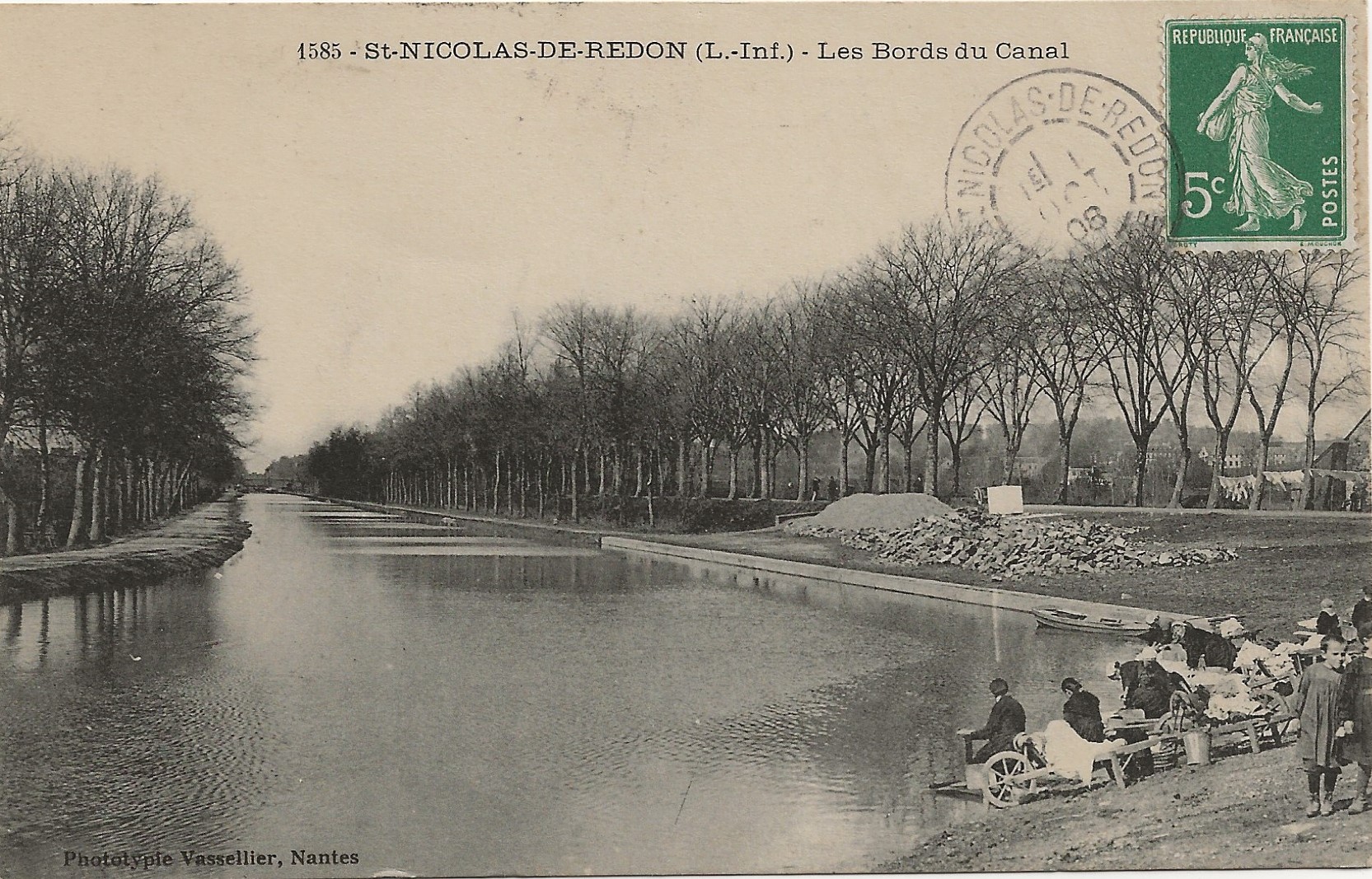
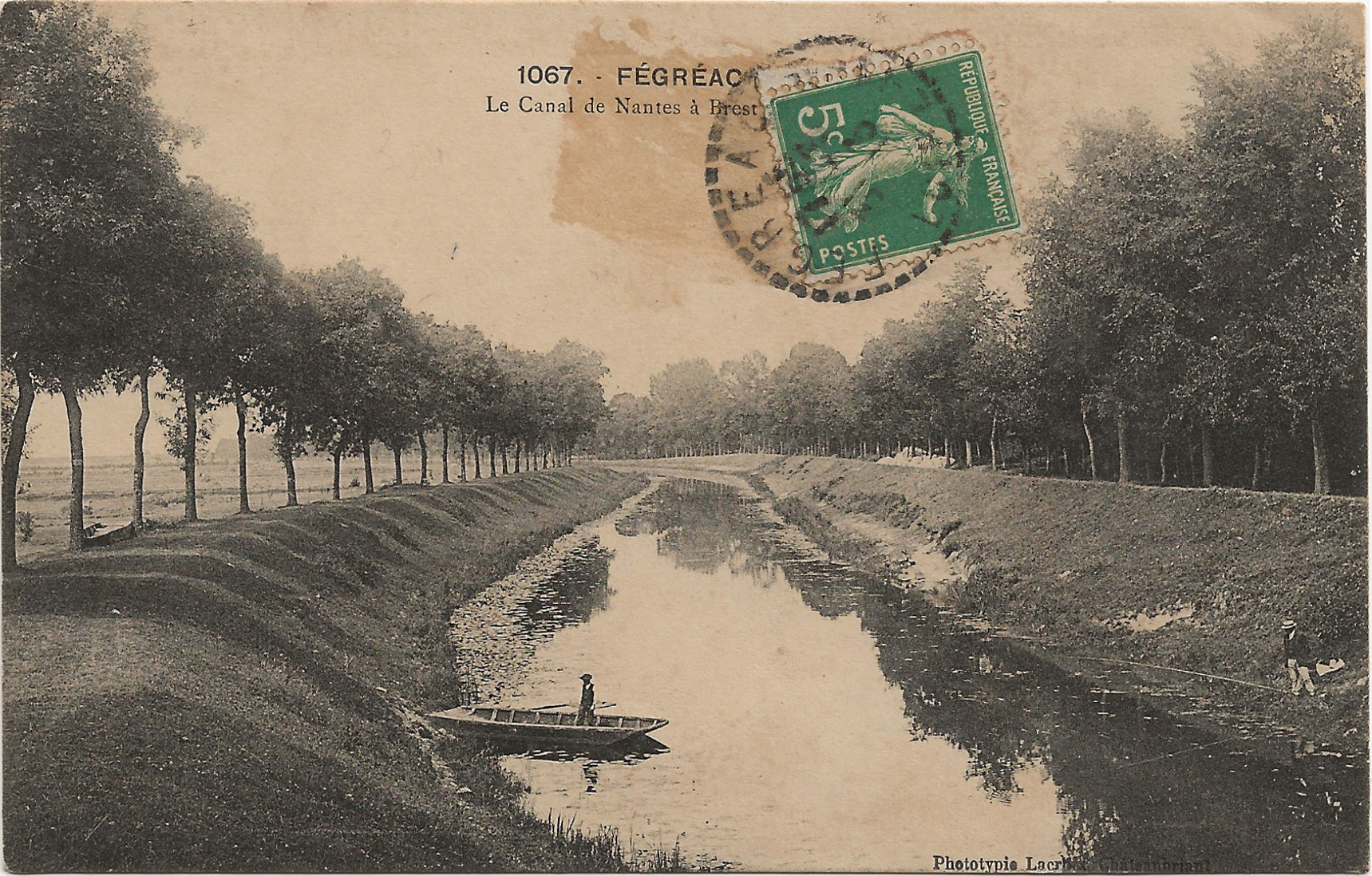

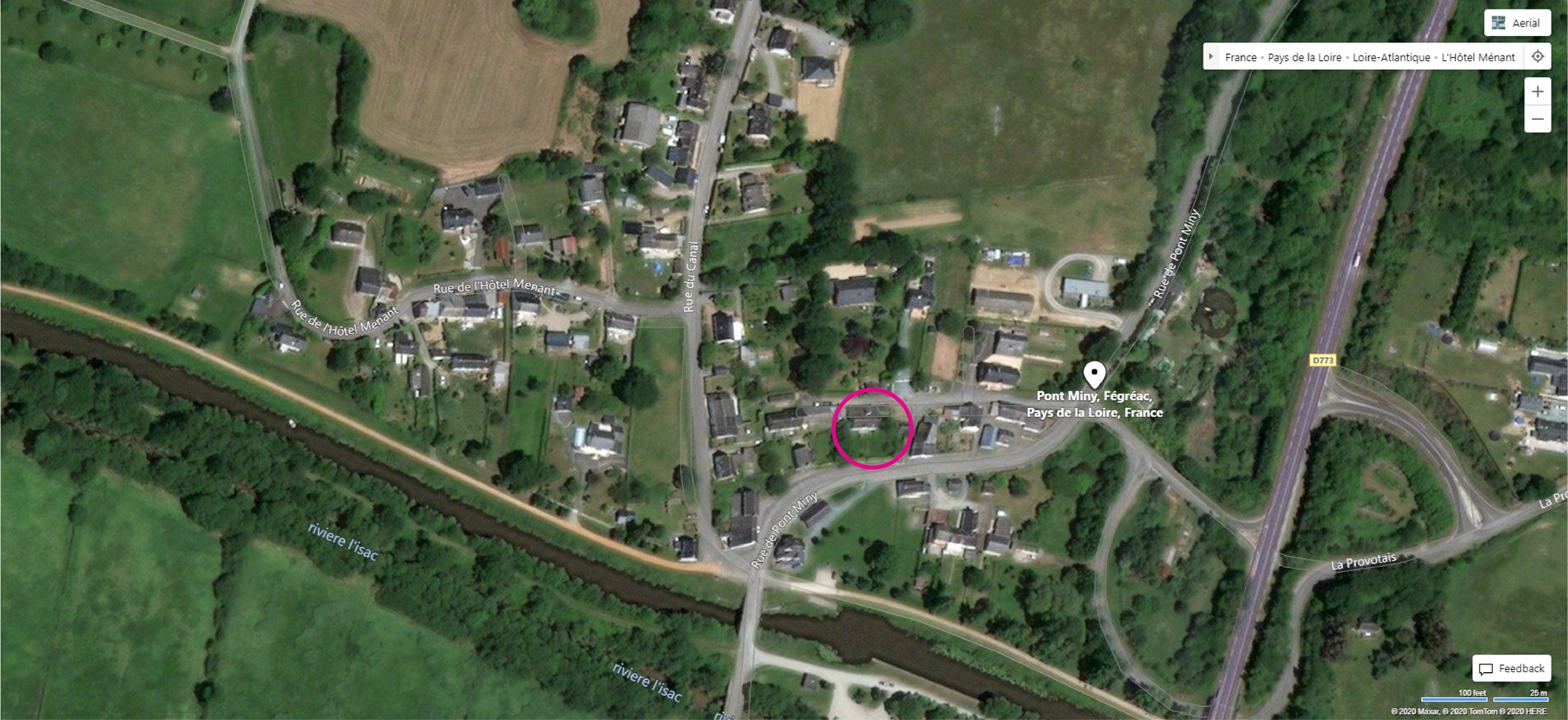
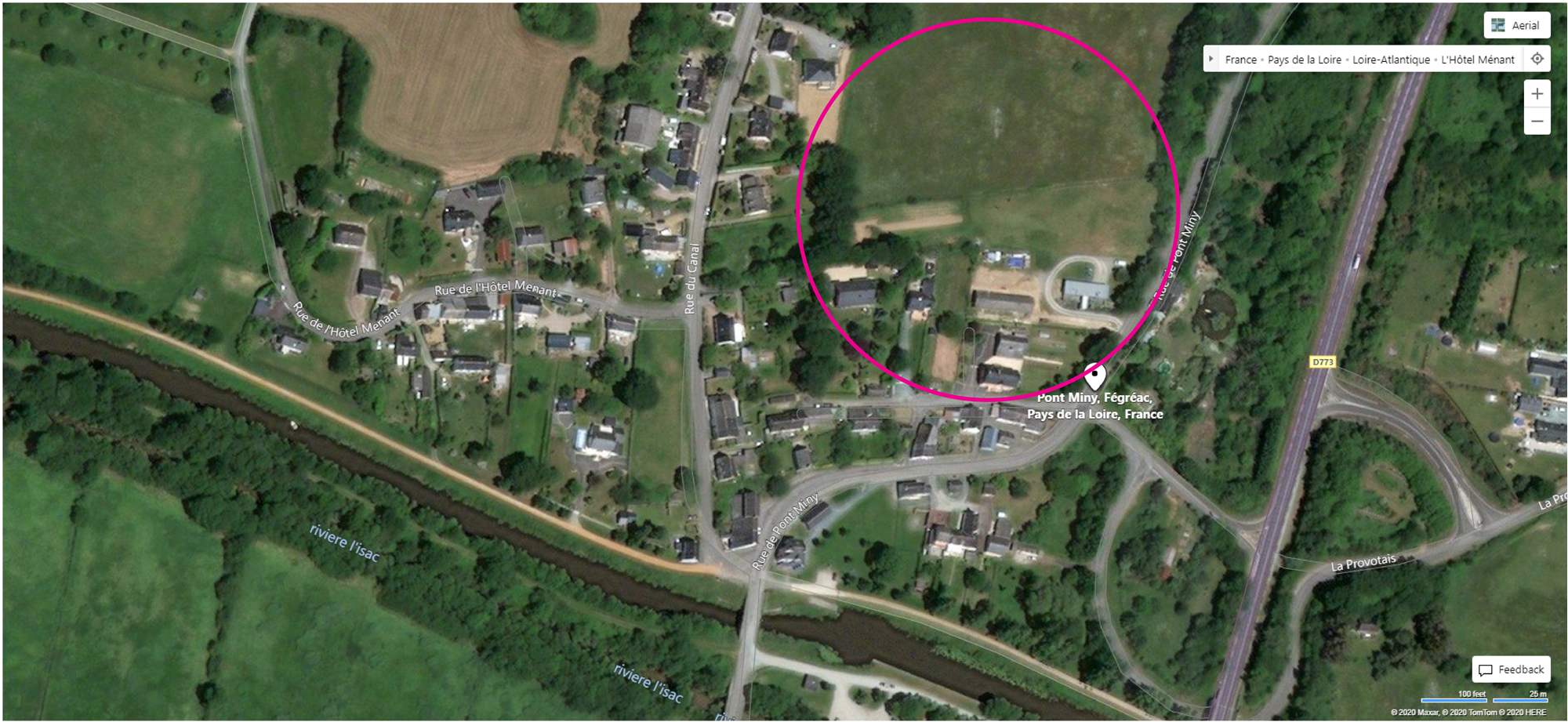
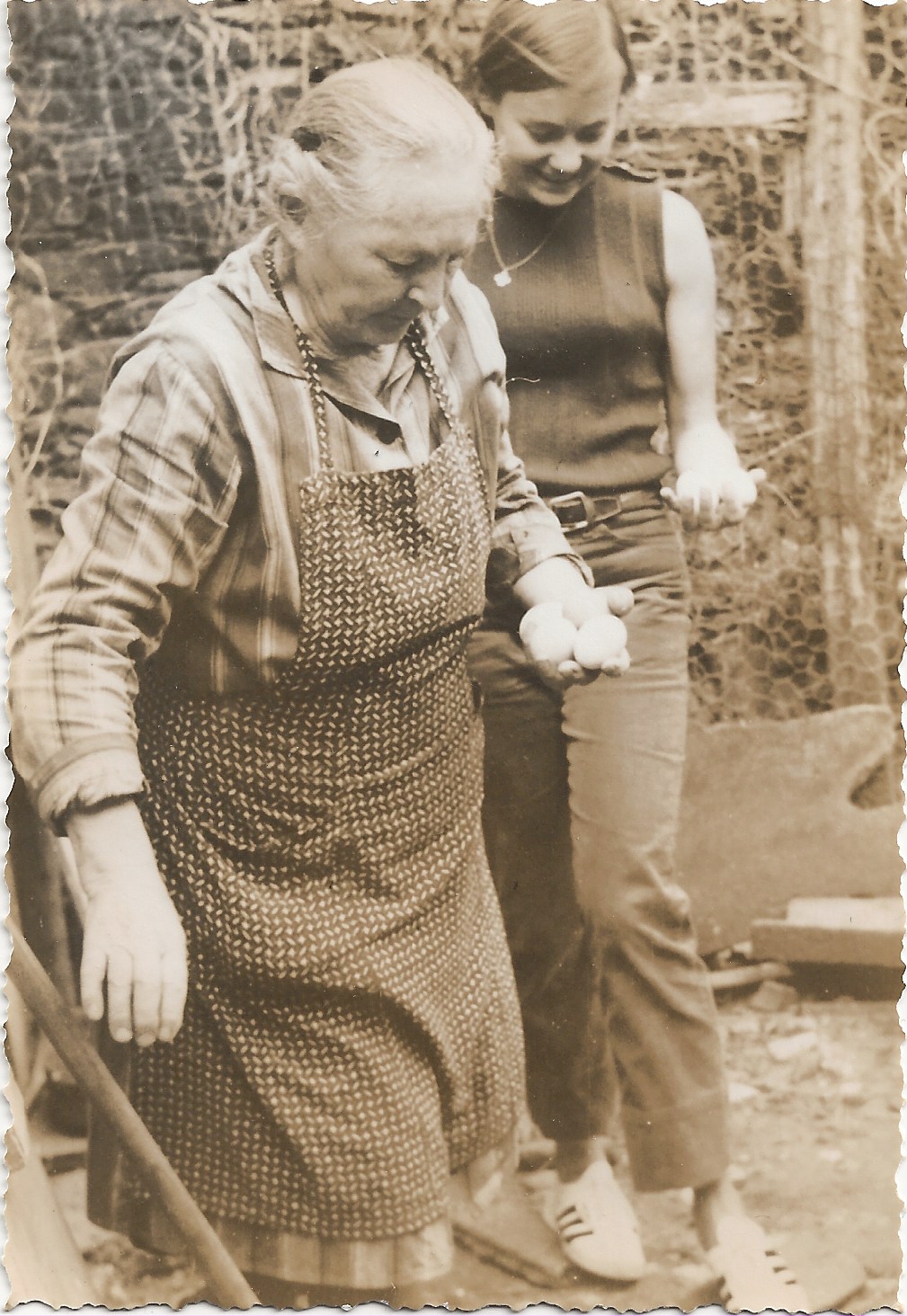


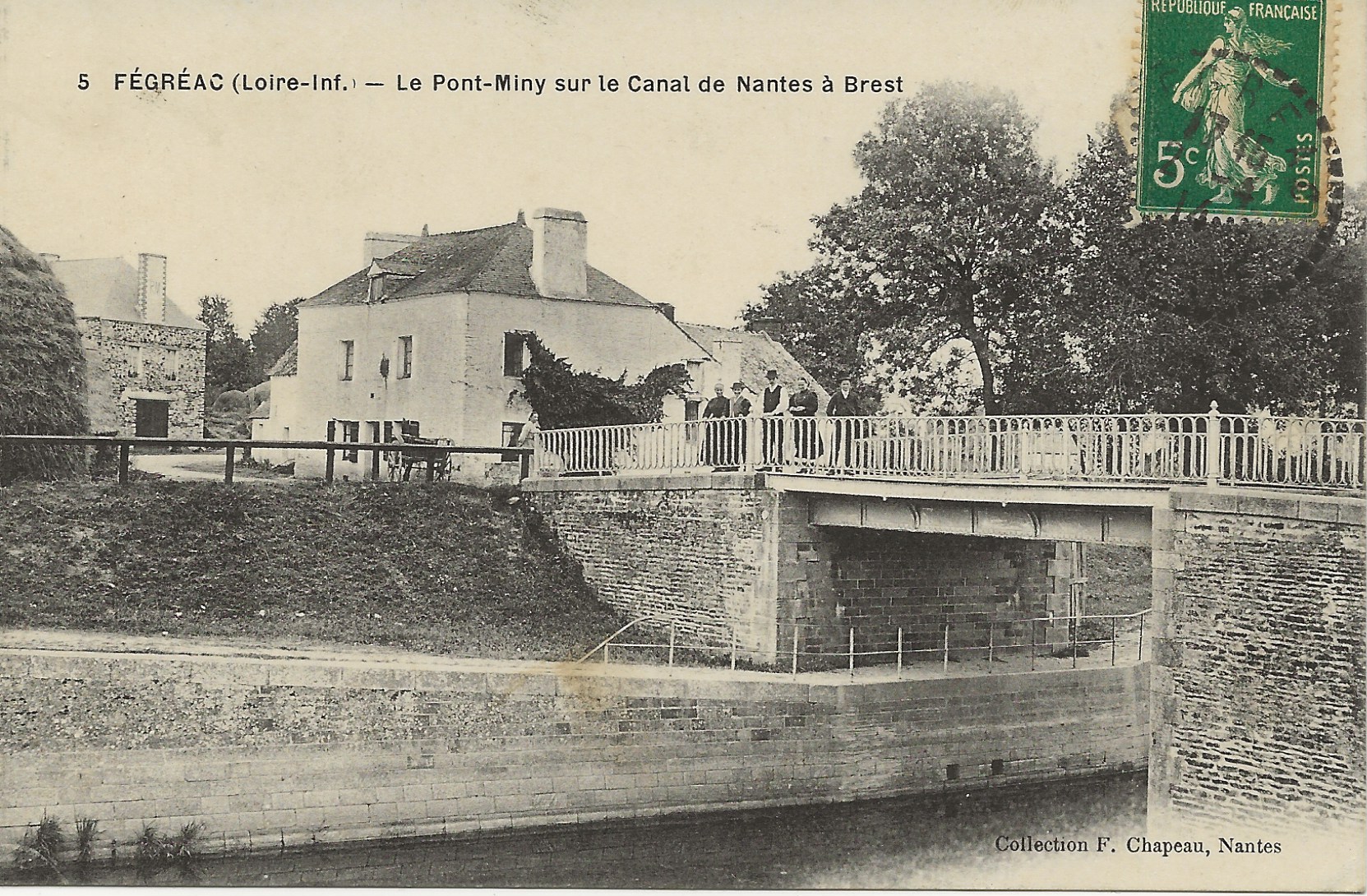
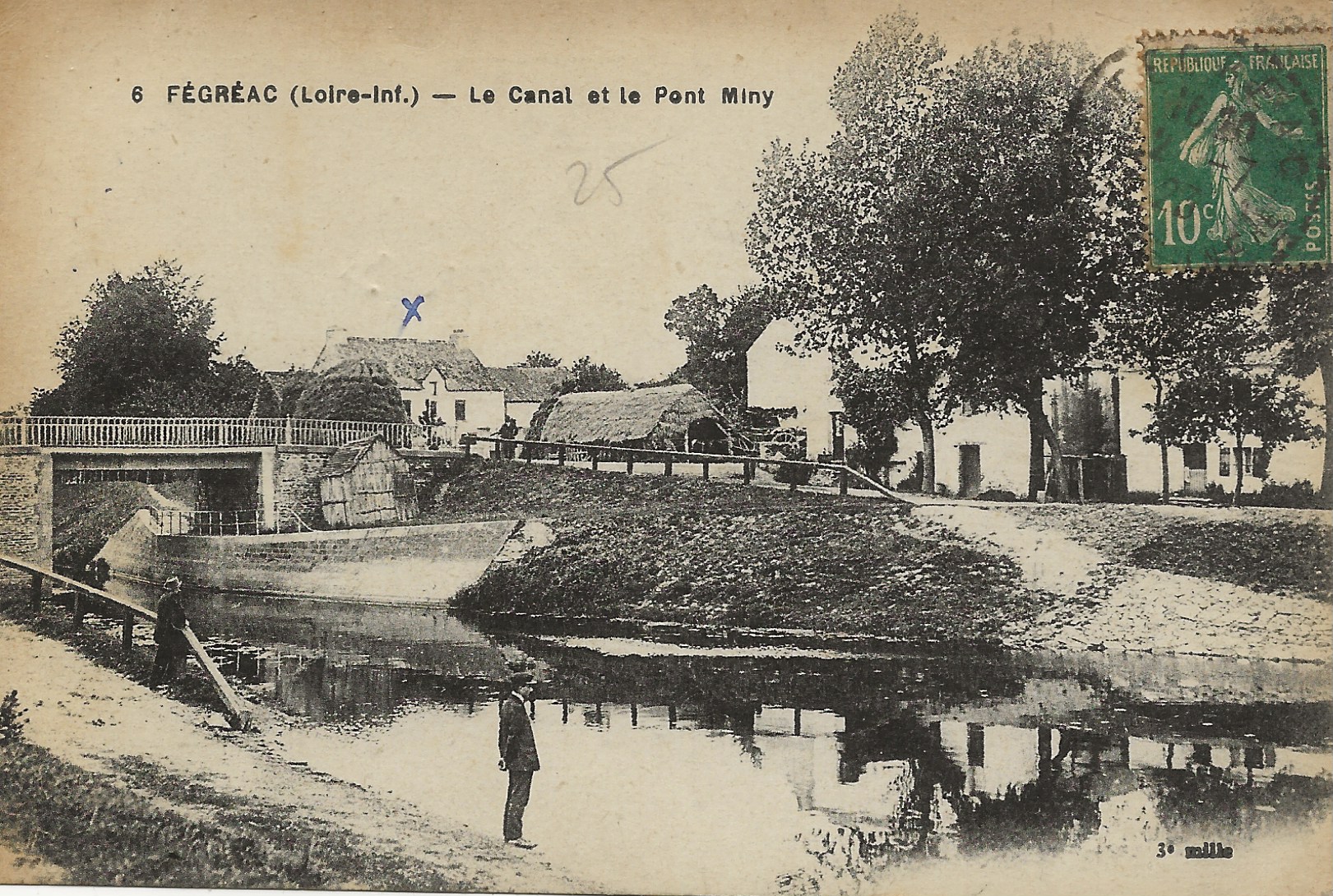
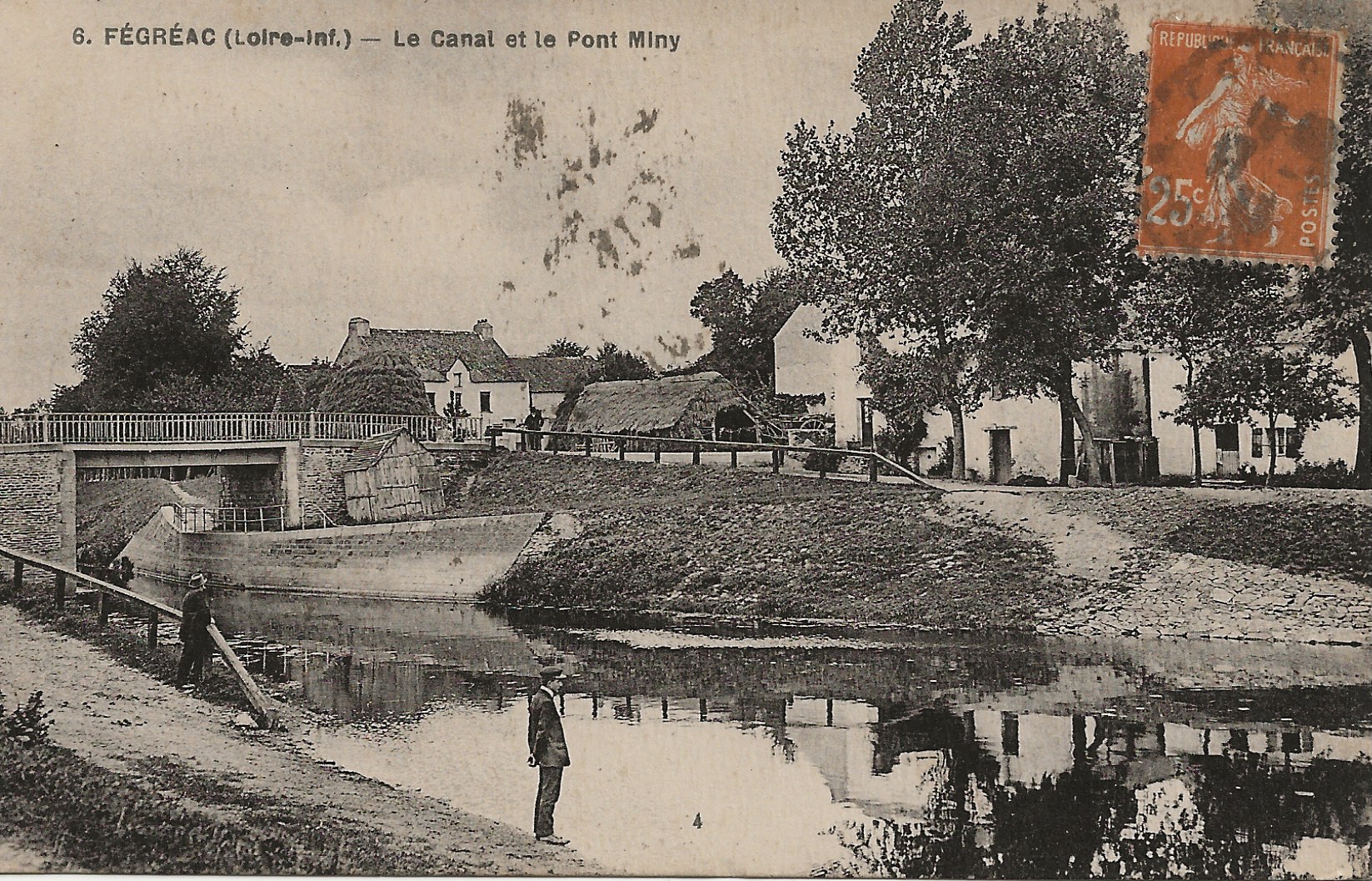
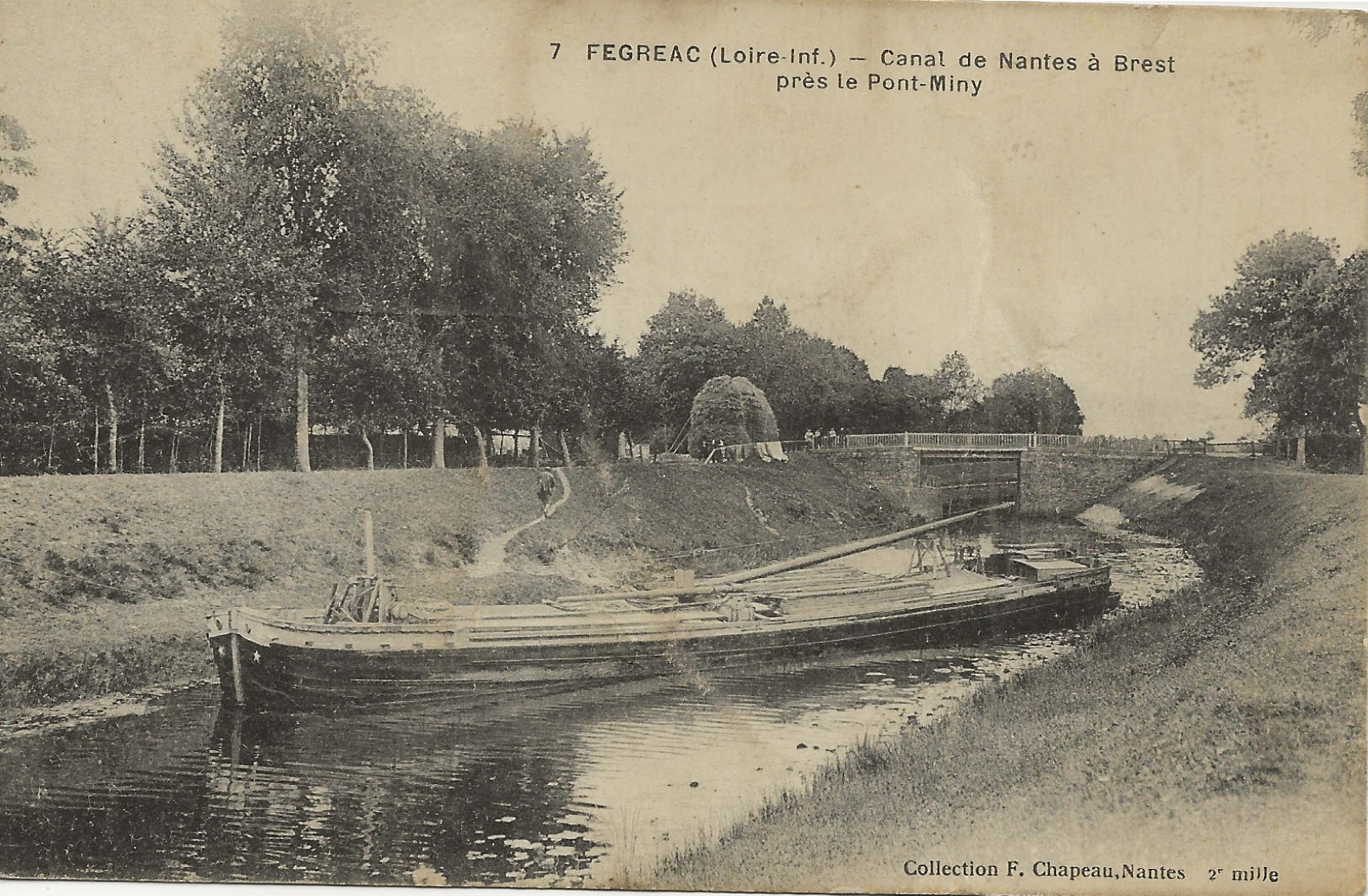

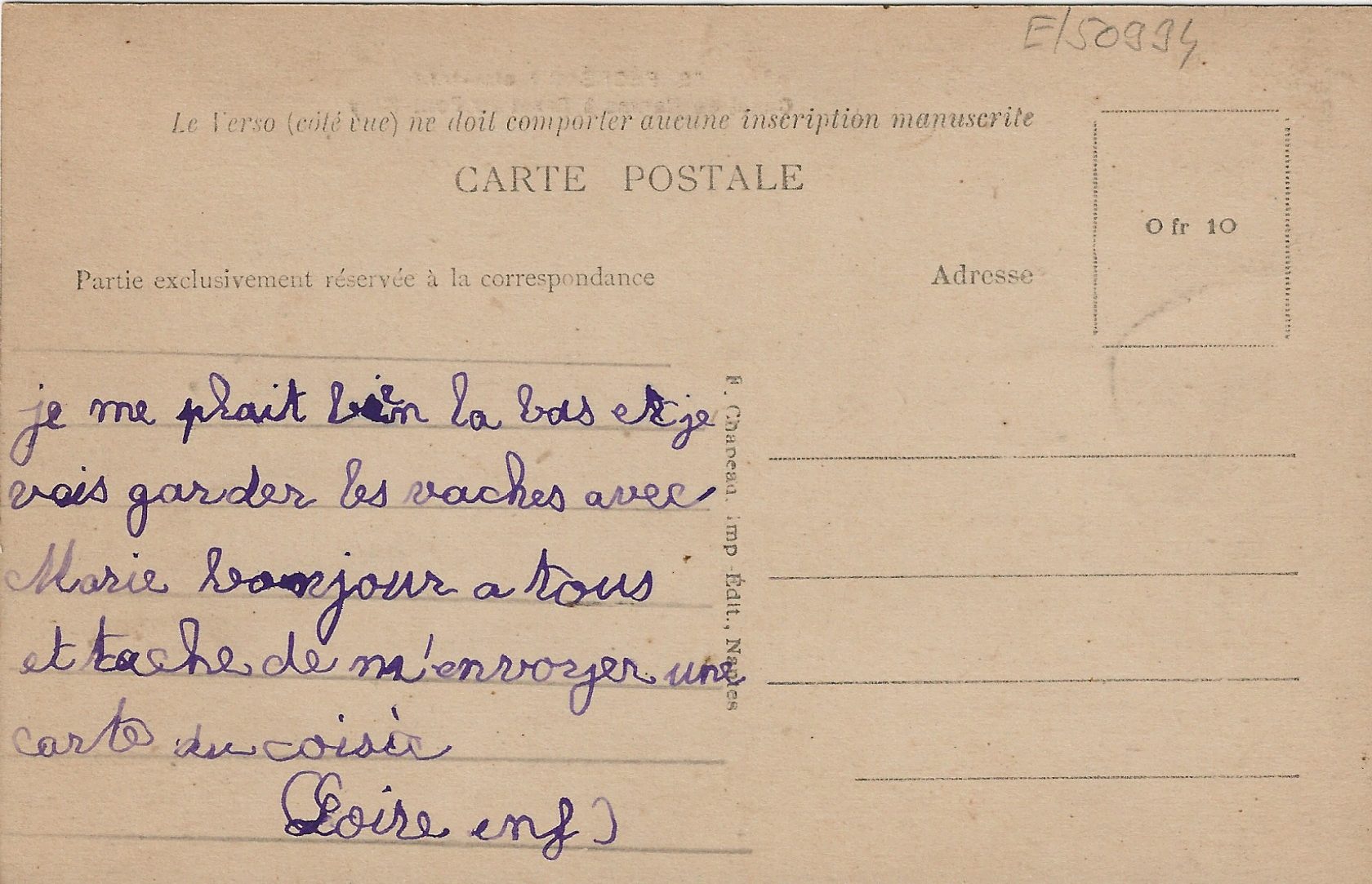
I’d say, first time Pont Miny enters the cybersphere, Steve! Nice progression and takes me back to those bons vieux temps! So many stories can be told about Pont Miny, including the grandfather clock and boules along the canal. The double-chimneyed house I believe housed the town’s only cafe on the ground floor but I don’t believe we ever set foot inside, Adeline would not have approved…
Great blog post Steve. I so enjoyed the read and viewing these rare post cards.
Je reconnais Pont-Miny et plein de souvenirs font surface, avec mon arrière grand-mère! Merci pour ces images moins connues.
Ca m’a fait plaisir de ressusciter quelques souvenirs enfouis dans ma mémoire. J’aimerais en faire ressurgir d’autres mais dans ma vie de retraitée, je me sens très morcelée… Bravo, en ce qui te concerne, de conduire sur autant d’années cette production écrite autour des cartes postales anciennes… c’est très éclairant sur notre passé rapproché, ça permet d’avoir le sentiment d’avoir participé un peu à la fabrication de l’Histoire.
Quel talent pour faire revivre ce petit bout de Bretagne !!
Merci à tous les contributeurs et surtout aux anecdotes qui sont une partie qui m’était inconnue de notre histoire commune.
Merci Steve pour ton travail historique et ton amour pour la France…
J’espère à bientôt !!!
Que de souvenirs, de fraises ramassées et de balades avec Maman Raymonde le long du canal…
Je revois très précisément toutes les bêtises qu’on a pu faire, les gamelles qu’on a pu se prendre en vélo avec Martin et les petits enfants des voisins !
Le dernier été que j’ai passé à Pont Miny, je me levais le matin avec une tasse de café, et allais la boire devant le canal, je crois que c’était mon moment préféré de la journée.
On a tous en nous quelque chose de Pont Miny ; merci Steve pour ce fabuleux travail qui fait remonter de très beaux souvenirs…